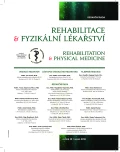Stroke: Recommendations for Patients and Their Families
Authors:
I. Kovářová; A. Oktábcová; T. Gueye; O. Švestková
Authors‘ workplace:
Klinika rehabilitačního lékařství 1. LF UK a Všeobecné fakultní nemocnice v Praze,
přednostka doc. MUDr. O. Švestková, Ph. D.
Published in:
Rehabil. fyz. Lék., 25, 2018, No. 3, pp. 126-130.
Category:
Original Papers
Overview
Stroke is a very serious and common disease with a high mortality. It is important for patients to start rehabilitation as soon as possible to ensure the use of time-limited brain plasticity. Early discharge from the hospital allows stroke patients homecoming to continue rehabilitation in familiar surroundings according to the patient’s choice. The responsibility for continued rehabilitation is in the hands of patients and their families and the main aim is to adjust the everyday life, reach the maximum of self-sufficiency and return to work if it is possible.
However, discharge from the hospital is sometimes critical for older patients because of lower functional abilities in activities and participations. Some tasks and activities should be difficult for these patients, sometimes appears higher risks, motor, cognitive and facial problems and fear of failure. It is very important for patients to increase their awareness of available services, the possibilities of ensuring the safety home environment and the availability of the necessary services. For the time and financial reasons, it is almost impossible to provide a home visit for all patients by an occupational therapist to evaluate the home environment, or even propose its treatments and equipment with compensatory aids. For this reason, occupational therapists in the Czech Republic try to increase the awareness of patients before their discharge from hospital. To raise awareness of patients, a “Summary of Recommendations for patients and their families” was written to provide stroke patients and their families with a clear set of information that is important for increasing self-sufficiency in the home environment.
Keywords:
stroke, rehabilitation, occupational therapy, recommendations, community rehabilitation, home environment, activities of daily living, ADL
Sources
1. BÉJOT, Y., BAILLY, H., DURIER, J., GIROUD, M.: Epidemiology of stroke in Europe and trends for the 21st century. La Presse Médicale [online], 45, 2016, 12, e391-e398 [cit. 2018-04-26]. DOI: 10.1016/j.lpm.2016.10.003. ISSN 07554982. Dostupné z: http://linkinghub.elsevier.com/retrieve/pii/S0755498216303098.
2. CLEMSON, L., LANNIN, N. A., WALES, K. et al.: Occupational therapy predischarge home visits in acute hospital care: A randomized trial. Journal of the American Geriatrics Society [online], 64, 2016, 10, s. 2019-2026 [cit. 2018-04-18]. ISSN 00028614. Dostupné z: http://doi.wiley.com/10.1111/jgs.14287.
3. Dartmouth - Hitchcock Medical Center: Learning about Stroke. A Guide for Patients and Families [online]. 2012. Dostupné z: http://www.dartmouth-hitchcock.org/documents/stroke_guide.pdf
4. DWORZYNSKI, K., RITCHIE, G., PLAYFORD, E. D.: Stroke rehabilitation: long-term rehabilitation after stroke. Clinical Medicine [online], 15, 2015, 5, s. 461-464 [cit. 2018-04-28]. ISSN 1470-2118. Dostupné z: http://www.clinmed.rcpjournal.org/cgi/doi/10.7861/clinmedicine.15-5-461.
5. EDMANS, J.: Occupational therapy and stroke. 2nd ed. Chichester, West Sussex, U.K.: Blackwell Pub., 2010. ISBN 978-1-4051-9266-8.
6. ERUDIS, o. p. s.: Neurorehabilitace - jak se zorientovat? Příručka pro osoby se získaným poškozením mozku a jejich rodiny, 2014.
7. FEIGIN, V. L.: Cévní mozková příhoda: prevence a léčba mozkového iktu. 1. české vyd. Praha, Galén, c2007. ISBN 978-80-7262-428-7.
8. KALITA, Z.: Akutní cévní mozkové příhody: diagnostika, patofyziologie, management. Praha, Maxdorf, 2006. ISBN 80-85912-26-0.
9. KOVÁŘOVÁ, I.: Soubor doporučení pro osoby po cévní mozkové příhodě a jejich rodiny po propuštění z včasných iktových lůžek. [Summary of Principles and Recommendations for Stroke Patients and their Families after Discharge from Acute Stroke Units]. Praha, 2018. 171 stran, 8 příloh. Diplomová práce. Univerzita Karlova, 1. lékařská fakulta, Klinika rehabilitačního lékařství 1. LF UK a VFN v Praze. Vedoucí závěrečné práce Mgr. Alice Oktábcová.
10. RÖTHLISBERGER, F., SCHMITT, K., SCHEEL-SAILER, A., BOES, S., RUBINELLI, S.: Challenges and potential improvements in the admission process of patients with spinal cord injury in a specialized rehabilitation clinic - An interview based qualitative study of an interdisciplinary team. BMC Health Services Research [online], 17, 2017, 1 [cit. 2018-01-14]. ISSN 14726963. Dostupné z: https://www.ncbi.nlm.nih.gov/pmc/articles/PMC5485498/.
11. ŠKODA, O., HERZIG, R., MIKULÍK, R. et al.: Klinický standard pro diagnostiku a léčbu pacientů s ischemickou cévní mozkovou příhodou a s tranzitorní ischemickou atakou - verze 2016. Česká a Slovenská Neurologie a Neurochirurgie [online], 2016, 3, s. 351-363 [cit. 2018-03-25]. ISSN 12107859. Dostupné z: http://www.csnn.eu/ceska-slovenska-neurologie-clanek/klinicky-standard-pro-diagnostiku-a-lecbu-pacientu-s-ischemickou-cevni-mozkovou-prihodou-a-s-tranzitorni-ischemickou-58279.
12. ŠTĚTKÁŘOVÁ, I., EHLER, E., JECH, R.: Spasticita a její léčba. Praha, Maxdorf, c2012. Jessenius, ISBN 978-80-7345-302-2.
13. ŠVESTKOVÁ, O., ANGEROVÁ, Y., DRUGA, R., PFEIFFER, J., VOTAVA, J.: Rehabilitace motoriky člověka: fyziologie a léčebné postupy. Praha, Grada Publishing, 2017. ISBN 9788027100842.
14. VINING, R. D., GOSSELIN, D. M., CASE, K., THURMOND, J., BRUCH, F. R.: Interdisciplinary rehabilitation for a patient with incomplete cervical spinal cord injury and multimorbidity A case report. Medicine [online], 96, 2017, 34 [cit. 2018-01-14]. ISSN 00257974. Dostupné z: https://www.ncbi.nlm.nih.gov/pubmed/28834891.
15. Věstník Ministerstva zdravotnictví České republiky, ročník 2010, částka 2, vydáno: 1. března 2010, Obsah: Péče o pacienty s cerebrovaskulárním onemocněním v České republice. Dostupné z: https://www.mzcr.cz/Legislativa/dokumenty/vestnik-c4/2012_6288_2510_11.html.
16. WINSTEIN, C. J., STEIN, J., ARENA, R. et al.: Guidelines for adult stroke rehabilitation and recovery. Stroke [online], 47, 2016, 6, e98-e169 [cit. 2018-04-10]. ISSN 0039-2499. Dostupné z: http://stroke.ahajournals.org/lookup/doi/10.1161/STR.0000000000000098.
17. Zákon 372/2011 Sb. v platném znění ze dne 6. listopadu 2011 o zdravotních službách a podmínkách jejich poskytování. Dostupné z: https://www.zakonyprolidi.cz/cs/2011-372#cast2
Labels
Physiotherapist, university degree Rehabilitation Sports medicineArticle was published in
Rehabilitation & Physical Medicine

2018 Issue 3
- Hope Awakens with Early Diagnosis of Parkinson's Disease Based on Skin Odor
- Deep stimulation of the globus pallidus improved clinical symptoms in a patient with refractory parkinsonism and genetic mutation
Most read in this issue
- Stroke: Recommendations for Patients and Their Families
- Activation of Breathing in Upper Crossed Syndrome
- Efficiency of Robot-assisted Therapy through the Device Armeo Spring in Patients after Stroke in Acute Phase of Early Rehabilitation
- Possible Influence of Increased Frequency by Manual Treatment of Ligamentum Pubovesicale
